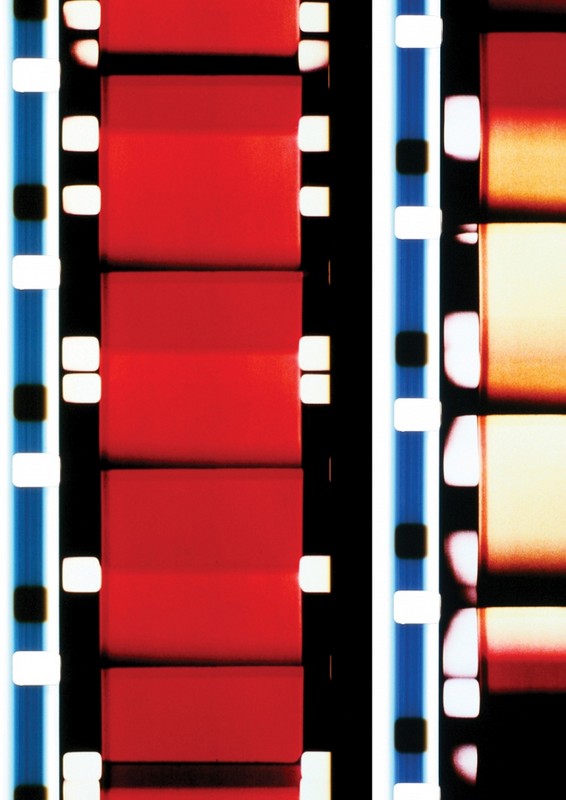Paul Sharits
23 Nov 2014 - 22 Feb 2015
PAUL SHARITS
Eine Retrospektive
23 November 2014 – 22 February 2015
Curated by Susanne Pfeffer
“I wish to abandon imitation and illusion and enter directly into the higher drama of: celluloid, two-dimensional strips; individual rectangular frames; the nature of sprockets and emulsion; projector operations; the three-dimensional light beam; environmental illumination; the two-dimensional reflective screen surface; the retinal screen, optic nerve and individual psycho-physical subjectivities of consciousness.”
Paul Sharits, 1967
Working with precisely composed 16mm films, the American experimental filmmaker Paul Sharits (1943–1993) created extraordinary cinematic spaces characterized by a degree of complexity and density that is unique in the history of art. In his installations and multiple projections (locational film pieces) he transforms film not only into a deeply visual, but also a profoundly physical experience. Meticulously arranged colour compositions (Shutter Interface, 1975), deceptive film-in-film presentations (3rd Degree, 1982) and abstract sequences interrupted by graphic images (Epileptic Seizure Comparison, 1976) form the basis for his reflections on the functions and conditions of the medium of film. Sharits’ work masterfully combines a sense-penetrating intensity with reflections on filmic illusion and the mechanisms of seeing.
In his Frozen Film Frames, he reduces film to its essential components, causing it to freeze into sculpture floating in space: Between suspended Plexiglas panes he mounts strips of film arranged side by side in such a way that they can be viewed both vertically and horizontally. Sharits reduces film to its essential components, celluloid and light, thereby divesting it of its fundamental determinants, namely time and motion.
Analogous to his cinematic pieces, Sharits continues to experiment with analytical and rhythmic colour composititions in numerous graphic works. In his diptychs and series executed in felt-tip on graph paper he places studies alongside the films, thereby creating a film notation that is entirely his own. In the early 1980s Sharits turned his attention once again to the roots of his art and thus to painting. Here as well, he was concerned primarily with the function and conditions of the medium and abstract compositions alternate with graphic representational works.
For the first time ever, the Paul Sharits retrospective unites four film installations (locational film pieces) within a single exhibition. In addition to single-screen projections, various Frozen Film Frames and numerous drawings, the show presents his late paintings as well as a number of previously unexhibited works. The Fridericianum is pleased to present the world’s first comprehensive retrospective devoted to the art of Paul Sharits.
A catalogue will be published by the Verlag der Buchhandlung Walther König. In addition to articles by Paul Chan, Tony Conrad, Birgit Hein, Bruce Jenkins, Branden W. Joseph, Helen Marten, Jonas Mekas, Susanne Pfeffer and Melissa Ragona, the publication will also feature essays on film theory by Paul Sharits, some of which have never been published before, and an extensive catalogue raisonné.
Eine Retrospektive
23 November 2014 – 22 February 2015
Curated by Susanne Pfeffer
“I wish to abandon imitation and illusion and enter directly into the higher drama of: celluloid, two-dimensional strips; individual rectangular frames; the nature of sprockets and emulsion; projector operations; the three-dimensional light beam; environmental illumination; the two-dimensional reflective screen surface; the retinal screen, optic nerve and individual psycho-physical subjectivities of consciousness.”
Paul Sharits, 1967
Working with precisely composed 16mm films, the American experimental filmmaker Paul Sharits (1943–1993) created extraordinary cinematic spaces characterized by a degree of complexity and density that is unique in the history of art. In his installations and multiple projections (locational film pieces) he transforms film not only into a deeply visual, but also a profoundly physical experience. Meticulously arranged colour compositions (Shutter Interface, 1975), deceptive film-in-film presentations (3rd Degree, 1982) and abstract sequences interrupted by graphic images (Epileptic Seizure Comparison, 1976) form the basis for his reflections on the functions and conditions of the medium of film. Sharits’ work masterfully combines a sense-penetrating intensity with reflections on filmic illusion and the mechanisms of seeing.
In his Frozen Film Frames, he reduces film to its essential components, causing it to freeze into sculpture floating in space: Between suspended Plexiglas panes he mounts strips of film arranged side by side in such a way that they can be viewed both vertically and horizontally. Sharits reduces film to its essential components, celluloid and light, thereby divesting it of its fundamental determinants, namely time and motion.
Analogous to his cinematic pieces, Sharits continues to experiment with analytical and rhythmic colour composititions in numerous graphic works. In his diptychs and series executed in felt-tip on graph paper he places studies alongside the films, thereby creating a film notation that is entirely his own. In the early 1980s Sharits turned his attention once again to the roots of his art and thus to painting. Here as well, he was concerned primarily with the function and conditions of the medium and abstract compositions alternate with graphic representational works.
For the first time ever, the Paul Sharits retrospective unites four film installations (locational film pieces) within a single exhibition. In addition to single-screen projections, various Frozen Film Frames and numerous drawings, the show presents his late paintings as well as a number of previously unexhibited works. The Fridericianum is pleased to present the world’s first comprehensive retrospective devoted to the art of Paul Sharits.
A catalogue will be published by the Verlag der Buchhandlung Walther König. In addition to articles by Paul Chan, Tony Conrad, Birgit Hein, Bruce Jenkins, Branden W. Joseph, Helen Marten, Jonas Mekas, Susanne Pfeffer and Melissa Ragona, the publication will also feature essays on film theory by Paul Sharits, some of which have never been published before, and an extensive catalogue raisonné.

